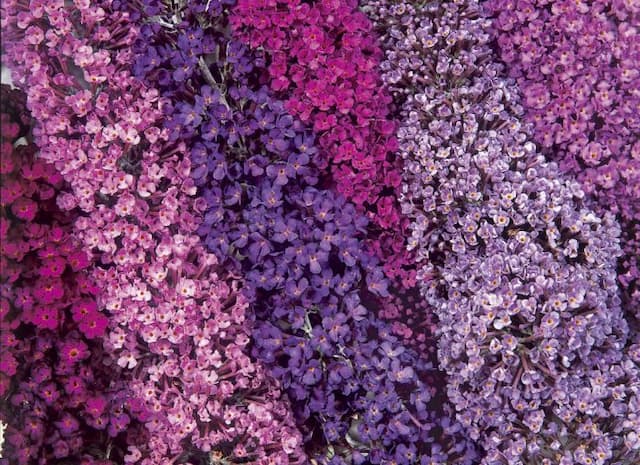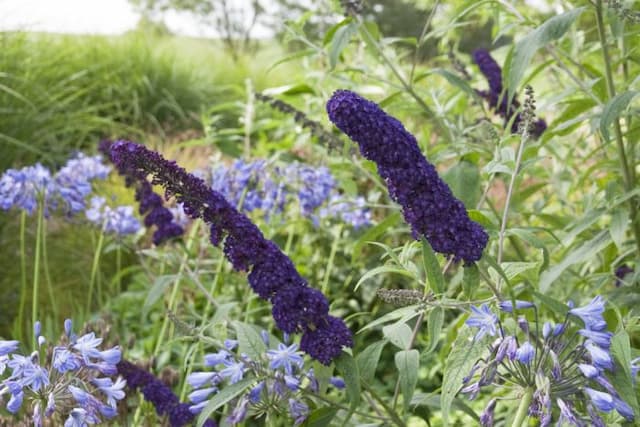Mullein Verbascum 'Jackie'

ABOUT
Verbascum 'Jackie' is characterized by its charming and distinctive presence in the garden, presenting a soft, rosette base of foliage from which emerges a central spike adorned with blooms. The leaves are typically fuzzy and have a gray-green hue that provides a unique textural element. The flowers that grace this plant are an enchanting shade of apricot-pink with a hint of lavender, transitioning to a lighter color toward the center, usually featuring a bright, warm-toned eye that creates a delightful contrast against the pastel petals. Verbascum 'Jackie' blooms exhibit a classic open-faced shape, reminiscent of a simple five-petalled figure. The blossoms are arranged in a dense, elongated cluster along the spike that rises from the center of the foliage, offering a showy display that can catch the eye from a distance. The plant exudes a cottage garden feel, and its flowers are favorites among pollinators such as bees and butterflies, which further enhances the visual appeal of the bloom-laden spike. Despite the omission of its physical dimensions, the plant's structure and form suggest a poised elegance with a vertical emphasis that is sure to stand out in any garden or landscape setting.
About this plant
 Names
NamesFamily
Scrophulariaceae
Synonyms
Mullein, Velvet Plant
Common names
Verbascum 'Jackie'.
 Toxicity
ToxicityTo humans
Common mullein (Verbascum 'Jackie') is not typically considered to be toxic to humans. Most parts of the plant are regarded as safe, and it has been used historically in herbal medicine. However, as with any plant material, there can be individual allergies or irritation, especially if the plant is handled extensively. It's always wise to exercise caution and seek medical advice if any adverse reactions appear after handling or ingesting any part of common mullein.
To pets
Common mullein is not listed as toxic to pets. This plant, while not intended for animal consumption, doesn't typically pose a risk of poisoning to dogs, cats, or other pets. If a pet were to ingest part of the plant, it's not expected to experience significant toxicity. However, as with any non-food plant, consumption in large quantities might cause gastrointestinal irritation or discomfort. If you notice any unusual symptoms after your pet consumes common mullein, it is best to consult a veterinarian.
 Characteristics
CharacteristicsLife cycle
Biennials
Foliage type
Deciduous
Color of leaves
Green
Flower color
Apricot
Height
2 feet [60 cm]
Spread
1 foot [30 cm]
Plant type
Herb
Hardiness zones
5
Native area
Europe
Benefits
 General Benefits
General Benefits- Attracts Pollinators: Verbascum 'Jackie', commonly known as Mullien, attracts bees and beneficial insects, helping to pollinate your garden.
- Drought Tolerant: Once established, Mullien is very drought-resistant, requiring minimal watering and maintenance.
- Erosion Control: The plant's root system helps to stabilize soil and prevent erosion, especially on slopes or in areas with loose soil.
- Long Blooming Period: Mullien has a lengthy flowering season, offering color and interest in the garden for an extended period.
- Deer Resistant: Its foliage is not preferred by deer, which makes it suitable for gardens in areas with a high deer population.
- Architectural Interest: With its tall flower spikes and rosette of leaves, Mullien adds vertical interest to garden beds and borders.
- Easy to Grow: This plant is easy to grow and relatively low-maintenance, perfect for beginner gardeners.
- Low Water Requirement: Mullien's low water needs make it ideal for water-wise gardens and xeriscaping.
- Attractive Foliage: The fuzzy, silvery leaves of Mullien add textural contrast to the garden.
- Self-sowing: It can self-seed under the right conditions, ensuring new plants appear in subsequent seasons without additional effort.
 Medical Properties
Medical PropertiesThis plant is not used for medical purposes.
 Air-purifying Qualities
Air-purifying QualitiesThis plant is not specifically known for air purifying qualities.
 Other Uses
Other Uses- Photographic Dye: The flowers of Mullein can be used to create a natural dye for photographic film, offering varying shades of yellow and brown.
- Fish Poison: Certain Native American tribes have used Mullein as a piscicide, which stuns or kills fish to make them easier to catch.
- Fire Starter: The dense, dry, and fluffy seed heads are excellent for holding a spark, making Mullein an aid in fire-making.
- Natural Insulation: The thick, woolly leaves of Mullein can be used as an insulating material in clothing and bedding for added warmth.
- Torch Making: Stalks of Mullein were historically dipped in tallow or wax to make torches due to their long-lasting burn quality.
- Insecticide: Mullein has been traditionally used to drive away insects and pests from granaries and other storage areas.
- Wick Material: The fine hairs on the leaves and stem can be twisted into a wick for oil lamps.
- Waterproofing Aid: Juice extracted from Mullein leaves was once used to coat wooden vessels to add water resistance.
- Livestock Feed: In some areas, Mullein is used as an emergency forage plant for livestock, especially sheep.
- Weather Prediction: Folklore suggests that the behavior of Mullein plants can indicate the weather, such as opening flowers for approaching rain.
Interesting Facts
 Feng Shui
Feng ShuiThe Mullein is not used in Feng Shui practice.
 Zodiac Sign Compitability
Zodiac Sign CompitabilityThe Mullein is not used in astrology practice.
 Plant Symbolism
Plant Symbolism- Healing: Verbascum, commonly known as Mullein, is historically linked to various medicinal uses. It symbolizes health and healing, as it has been traditionally used for its anti-inflammatory, antispasmodic, and expectorant properties.
- Protection: Folklore often associates Mullein with warding off evil and negative energies. It was believed to be a plant that could offer spiritual protection.
- Love Divination: In some traditions, Mullein was used in rituals to foresee the future in matters of love, symbolizing the quest for clarity and truth in one’s romantic affairs.
- Courage: Due to its tall and sturdy stalks, Mullein can symbolize taking a stand and represents courage and resilience in the face of adversity.
 Water
WaterThe Mullein 'Jackie', needs to be watered regularly to maintain evenly moist soil, especially during its growing season in spring and summer. This plant prefers a deep watering method, where you apply water at the base of the plant until it begins to run through the bottom of the container, suggesting the soil is thoroughly saturated. On average, watering once every 5 to 7 days should suffice, but always check the top inch of soil before watering; if it feels dry to the touch, it's time to water. Adjust the frequency to account for rainfall and changes in temperature, as these can change the plant's watering needs. It is generally better to provide water less frequently but more deeply, to encourage strong root growth.
 Light
LightMullein 'Jackie' thrives best in full sun conditions, where it can receive at least 6 to 8 hours of direct sunlight daily. The ideal spot for this plant would be an area that is exposed to unfiltered sunlight for most of the day. However, it can tolerate some light shade, especially in hotter climates, but too much shade can lead to reduced flowering and a leggy growth habit.
 Temperature
TemperatureMullein 'Jackie' is adaptable to a range of temperatures but grows best in conditions between 50 and 86 degrees Fahrenheit. It can survive minimum temperatures down to around 20 degrees Fahrenheit, making it suitable for many temperate gardens. During extreme heat, providing some afternoon shade can help protect the plant from stress.
 Pruning
PruningPruning Mullein 'Jackie' is beneficial for maintaining its shape and encouraging a more robust second bloom. Deadhead spent flowers to promote new flower production and cut back the plant after initial flowering to stimulate a second flush of blooms. Pruning is typically done mid-season, after the first bloom, and may be needed again in late fall to prepare the plant for winter.
 Cleaning
CleaningAs needed
 Soil
SoilThe Mullein 'Jackie' prefers well-draining soil with a light, sandy or loamy texture, and can thrive in a wide pH range from slightly acidic to neutral to slightly alkaline (pH 6.0-8.0). A mixture composed of equal parts garden soil, sand, and compost or well-rotted manure will provide an ideal growing medium for this plant.
 Repotting
RepottingMullein 'Jackie' does not need frequent repotting and can be repotted every 2-3 years, or when the plant has outgrown its current container.
 Humidity & Misting
Humidity & MistingMullein 'Jackie' is tolerant of a wide range of humidity conditions and does not require high humidity to thrive; it can perform well in average ambient humidity typical of outdoor environments.
 Suitable locations
Suitable locationsIndoor
Place Mullein 'Jackie' in bright, indirect light indoors.
Outdoor
Plant Mullein 'Jackie' in full sun with well-drained soil.
Hardiness zone
5-9 USDA
 Life cycle
Life cycleVerbascum 'Jackie', commonly known as Mullein 'Jackie', begins its life cycle as a seed, requiring well-drained soil and light for germination. The germinating seed develops into a seedling, where it will establish a rosette of leaves close to the ground over several weeks. As the plant matures, usually in its second year, it sends up a tall flowering stalk, which can reach up to 2 feet tall, and blooms with a succession of yellow to peach-colored flowers that are attractive to pollinators. After flowering, seed capsules form and disperse seeds, completing the reproductive cycle. Mullein 'Jackie' is a short-lived perennial or biennial, meaning it typically lives for two to three years. Once the plant has set seed, it may die back, though some plants may survive longer and enter a dormancy stage during the colder months before beginning the cycle again.
 Propogation
PropogationPropogation time
Spring-Early Summer
The most popular method of propagation for Verbascum 'Jackie', commonly known as Mullein 'Jackie', is by seed. The optimal time for sowing Mullein 'Jackie' seeds is in late winter to early spring, as this synchronizes with their natural germination cycle when they would typically sprout after winter's cold weather breaks. To propagate Mullein 'Jackie' by seeds, start by scattering the tiny seeds on the surface of a well-draining seed starting mix as they require light to germinate. Do not cover the seeds with soil. Moisten the soil gently, maintaining consistent moisture without allowing it to become waterlogged. Place the seed container in a warm, bright spot, avoiding direct sunlight, and keep temperatures around 65 to 70 degrees Fahrenheit (18 to 21 degrees Celsius). Germination should take place within two to three weeks, after which the seedlings can be gradually acclimated to outdoor conditions before transplanting them to their final position in the garden once the risk of frost has passed.


![Butterfly bush [Adonis Blue]](/_next/image?url=https%3A%2F%2Fplants-admin.emdemapps.com%2Fimages%2Fplants%2F%2Fimages%2F604b56e58f983.png&w=640&q=75)


![Butterfly bush [Buzz Ivory]](/_next/image?url=https%3A%2F%2Fplants-admin.emdemapps.com%2Fimages%2Fplants%2F%2Fimages%2F604b57987dfa8.png&w=640&q=75)
![Butterfly bush [Camberwell Beauty]](/_next/image?url=https%3A%2F%2Fplants-admin.emdemapps.com%2Fimages%2Fplants%2F%2Fimages%2F604b5ead04c12.png&w=640&q=75)


